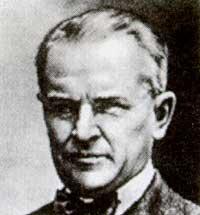In Millica, Robert Andrews
(1868-1953)
American physicist born in a family of Scottish origin in Illinois in 1868. He studied at the Universities of Berlin and Gottingen and received his doctorate from Columbia University in 1895. As a student, he showed no tendency to physics, but he was a physics professor in some schools at the end of primary school and even a doctorate when he obtained a doctorate degree at the University of Chicago.
Between 1906 and 1911 he began to develop his most prestigious research. Thanks to the research we know as "The oil drop experiment", Milliki managed to measure the load of the electron.

Through the microscope, the observer observes a drop of oil without knowing the number of electrons in the oil. Millikan used x-rays to create the electric field and observed that this area affected the amount of oil. Milliki thought that the weight of the oil drop and the power from above that generates the area on the oil drop should be equal, since in this way you can easily know the electric charge of the oil drop. If it is a repeated attempt, the value of the unit load can be known; in other words, Milliki achieved through this study to know the charge of an electron: 1,6,10-19 C approx.
In 1923 he was awarded the Nobel Prize in Physics in recognition of the discovery of the charge of the electron and its informative work throughout his career.
In 1921 he took over the Norman Bridge Laboratory at the California Institute of Technology. There he was able to learn about the research carried out by Hess. Hess indicated that from space there is a special radiation and some of the rays that reach us are an example of this. Millikan called cosmic rays and that is the terminology we have used since then.
During the last years of his life he went on to study the type of radiation in the different layers of the atmosphere. For this purpose he organized numerous expeditions all over the world, being the best known ones made in India and Australia. He was also a U.S. representative in the international scientific cooperation commissions between 1922 and 1932.
He was 85 when Herio went to California in 1953.
Buletina
Bidali zure helbide elektronikoa eta jaso asteroko buletina zure sarrera-ontzian











